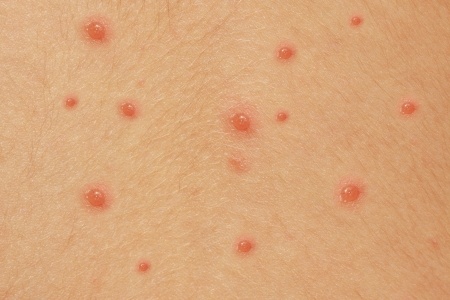How do you know if your child is suffering from chickenpox? Do you know any other symptoms of the disease apart from a red, itchy rash? Chickenpox was very common in the US before its vaccine was introduced in 1995. After that, Chickenpox cases have reduced significantly. Chances are that some young doctors and parents have not witnessed any case of the disease and may not be able to spot the condition when it occurs.
What does Chickenpox Look Like?
Chickenpox, also known as varicella is a viral disease that is characterized by a red, itchy rash. It is among the most infectious diseases in children. Most chickenpox cases are mild but pose risks of serious complications like bacterial pneumonia. Red pumps appear first but their appearance changes with time. Chickenpox undergoes five stages within 24 hours that include:
- Small red bumps
- Water blisters with thin walls
- Cloudy blisters
- Open sores
- Dry, brown crusts

Chickenpox starts with few red bumps or spots that look like insect bites. Your child may also experience a fever.The bumps increase the following day and the first bumps turn into blisters. By the third day, the second-day bumps will have turned into blisters and new bumps appear. On the fourth day, the first bumps crust over. More blisters form crusts on the fifth day but no new bumps appear. All blisters crust over by the seventh day. The fever may last up to the fifth day and the number of spots is estimated at 200.

A chicken pox rash will start on the face, chest, back and then spread to the rest of the body. It can appear on the eyelids, inside the mouth and on the genital area. A normal chicken pox rash leaves 200-500 blisters but extreme cases leave as many as 1000 blisters
Other Conditions That Resemble Chicken Pox
One major reason for addressing the question "what does chicken pox look like" is that there're many other conditions that would present similar conditions. Most of these conditions are usually mild and heal without any treatment. Some of the conditions that look like chicken pox include:
- Insect bites: Spider, mosquito and flea bites lead to blisters and bumps that resemble chickenpox bumps.

- Viral illness: Viral illness cause bumps, which often heal on their own without causing any harm.

- Contact dermatitis: Contact with some items and plants may cause bumps, which resolve on their own.

When to Seek Help
You should seek help in the following conditions:
- You suspect your child is suffering from chickenpox.
- Severe skin pain, red skin and a rash producing a greenish discharge accompany chickenpox. These are symptoms of another bacterial infection.
- Persistent sleepiness, stiff neck, and lethargy accompany chicken pox. These symptoms indicate other serious complications such as encephalitis and meningitis.
- Your child suffers from convulsions, fever, drowsiness, and vomiting when recovering from chickenpox.
- An adult in your family contracts chickenpox.
- You are exposed to chickenpox when pregnant and have never suffered from the disease.
How to Deal With It
After answering the question "what does chickenpox look like" you need to learn how you can protect your child. Chickenpox is highly contagious. Let your child stay at home until all the blister burst and crust over. Most chickenpox incidences do not require further treatment other than treating its symptoms.
Medical Treatments
Antiviral drugs such as acyclovir may be prescribed to reduce the duration of chickenpox. The prescription maybe given to pregnant women, patients whose immunity is weak and adult patients within 24 hours of the rash.
Your doctor may prescribe antihistamine and over-the-counter pain relievers to relieve swelling, itchiness and pain. Antibiotics are necessary when bacterial pneumonia or another bacterial skin infection accompany chickenpox.
Home Remedies
- Keep your child's hands covered with socks or mittens and the fingernails short to avoid scratching. Scratching may lead to an infection and scarring.
- Add baking soda or a handful of oats to bath water to relieve itching.
- Apply calamine lotion to the lesions to reduce itching.
- Leave your baby without a nappy for as long as possible so that vesicles can dry and scab.
- Prepare a gargle using half a teaspoon of sale and a glassful of water to relieve mouth sores. Older children can be given lozenges and sprays with mild anaesthetic.
- Give the right paracetamol for your child's age to relieve fever and symptoms of chicken pox.
- Wash sores daily to keep them clean and then apply lotion.
Chickenpox Vaccination
The best method of preventing chickenpox is the chickenpox vaccine. The vaccine protects 90% of the immunized children. In cases where the vaccine does not protect the child completely, it reduces the severity of the condition. The chickenpox vaccine or Varivax is administered to:
- Young children: The immunization routine in the US involves children between 12-15 months getting the first dose and children between 4-6 years the second dose.
- Older children who were not vaccinated: Unvaccinated children between 7-12 years should get two vaccine doses, which are administered 3 months apart. Children aged 13 years and above also get two doses, but given 4 weeks apart.
- Unvaccinated adults who have not suffered from chicken pox but face a high risk of contracting: These include military personnel, teachers, international travelers, children care workers, women of childbearing age, healthcares works and adults living with young children.
Can One Still Get Chickenpox After Vaccination?
Answering the question "whatdoes chickenpox look like" is necessary even if your child is vaccinated. Your child can suffer from chicken pox and develop blisters even after receiving the vaccine. People who receive the chickenpox can contract the disease but its symptoms are milder. Such incidences are referred to as breakthrough cases and may have less than 50 blisters. Only a few blisters appear in some cases.
